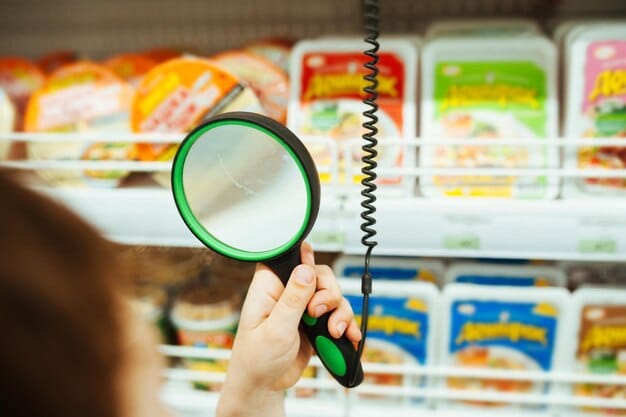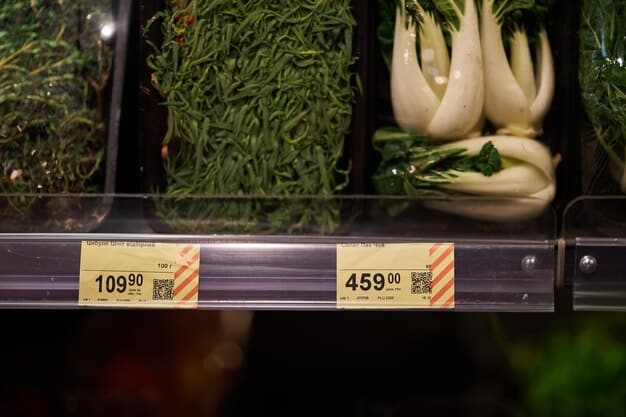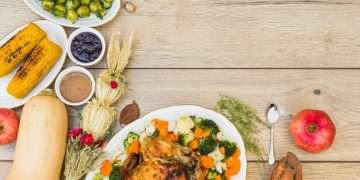2025 Guide: Food Labels & Healthy Choices

Navigating food labels in 2025 has become essential for making informed dietary choices, empowering consumers to understand nutritional content, ingredient lists, and health claims for a healthier lifestyle.
In an era brimming with dietary advice and evolving food trends, mastering the art of interpreting food labels is more critical than ever. This comprehensive resource, The 2025 Guide to Understanding Food Labels and Making Healthy Choices, is designed to empower you with the knowledge needed to confidently navigate the grocery aisles of tomorrow. Understanding what’s truly in your food is the first step towards a healthier, more informed lifestyle.
Understanding the Basics: The Nutrition Facts Panel
The Nutrition Facts panel remains the cornerstone of food label information. For 2025, while its core purpose largely endures, subtle shifts in data presentation and consumer understanding highlight its increasing importance. This section will break down the essential components you need to scrutinize.
Serving size, often overlooked, dictates everything else on the label. It’s crucial to match this to your actual consumption. If a package contains two servings, and you eat the whole thing, you’ve consumed double the listed nutrients and calories. This simple detail is where many people inadvertently derail their dietary goals.
Calories and Daily Values: What They Mean for You
Calories provide a measure of energy from food, yet their context within your daily needs is paramount. The “Daily Value” (DV) percentages alongside nutrients offer a quick reference point, typically based on a 2,000-calorie diet. However, individual caloric needs vary significantly based on age, gender, activity level, and health goals. A 5% DV or less is considered low, while 20% DV or more is considered high. Understanding these percentages helps put nutrient content into perspective for your overall diet.
- 2000-Calorie Baseline: Remember this is a general guide; adjust your intake based on personal requirements.
- Low vs. High DV: Use these benchmarks to quickly assess a food’s contribution to your daily nutrient intake.
- Personalized Needs: Consult nutrition professionals for a tailored understanding of your specific caloric and nutrient targets.
The updated DVs for 2025 reflect the latest scientific dietary recommendations. For instance, the DV for added sugars and total sugars may see continued emphasis, guiding consumers towards less sugary options. Similarly, updated recommendations for nutrients like Vitamin D and potassium ensure labels provide the most current and relevant health information.
Beyond the basics, the Nutrition Facts panel is evolving to offer more clarity. Expect to see clearer definitions of complex terms and perhaps even QR codes linking to deeper, validated information about specific nutrients or ingredient sourcing. This push towards enhanced transparency aims to equip consumers with a more robust understanding of their nutritional intake, moving beyond simple numbers to holistic dietary insights.
Deciphering Ingredient Lists: What’s Really Inside?
The ingredient list is arguably the most telling part of a food label, revealing the true composition of a product. By 2025, consumer demand for transparency means these lists are becoming even more critical. Ingredients are listed in descending order by weight, meaning the first few items constitute the largest portions of the product. This hierarchy is key to making informed decisions.
Beyond simply reading the names, understanding common aliases for ingredients, especially sugars and fats, is essential. Sugar, for example, can hide under names like high-fructose corn syrup, dextrose, maltose, or even fruit juice concentrate. Similarly, various types of oils and processed fats are crucial to identify for those managing specific dietary needs or health conditions.
Hidden Sugars, Fats, and Sodium: The Unseen Culprits
The food industry continues to innovate, leading to a proliferation of ingredients that can mask undesirable components. High levels of added sugars contribute to increased calorie intake without significant nutritional benefit, and are linked to various health concerns. Unhealthy fats, such as trans fats and unhealthy saturated fats, can impact heart health. Sodium, while essential in moderation, is often present in excessive amounts in processed foods, contributing to high blood pressure for some individuals.
- Sugar Aliases: Look out for words ending in “-ose” (dextrose, fructose), syrups (corn syrup), and concentrates.
- Fat Types: Differentiate between healthy fats (avocado oil, olive oil) and less desirable ones (partially hydrogenated oils).
- Sodium Traps: Be mindful of high sodium levels, especially in canned goods, frozen meals, and processed meats.
Manufacturers are adapting to heightened consumer awareness, and some are proactively simplifying ingredient lists and offering more whole-food-based options. However, vigilance remains paramount. Emerging ingredients, such as new plant-based proteins or alternative sweeteners, will also necessitate careful review. Understanding their origin and processing methods will become increasingly important for health-conscious consumers in 2025.
Furthermore, allergens and sensitivities are gaining more prominent display on labels, often in bold text or in a dedicated “Contains” statement. This improved clarity helps individuals avoid severe allergic reactions, reflecting a growing industry commitment to public health and safety. Always double-check this section if you have any known allergies.
Understanding Health Claims and Certifications
Food labels are often adorned with a myriad of health claims and certifications, designed to catch your eye and influence purchasing decisions. However, not all claims are created equal. Distinguishing between marketing hype and scientifically backed statements is crucial for making genuinely healthy choices.
Terms like “natural,” “whole grain,” or “light” are frequently used, but their meanings can vary widely. For instance, “natural” is often loosely defined and doesn’t necessarily mean a product is free from processing or artificial ingredients. “Whole grain” requires a closer look at the ingredient list to ensure “whole” components are among the first ingredients, not refined grains or just a sprinkling of whole flour.

Decoding “Free From” and “Low In” Claims
Claims such as “gluten-free,” “dairy-free,” “sugar-free,” “low fat,” or “sodium-reduced” appeal to specific dietary needs or preferences. While these claims can be helpful, it’s important to understand what they truly entail. A “gluten-free” product, for example, is suitable for those with celiac disease or gluten sensitivity, but it doesn’t automatically mean it’s healthier overall; it could be high in sugar or unhealthy fats to compensate for texture or flavor. Similarly, “low fat” might mean increased sugar or sodium to maintain palatability.
- “Gluten-Free”: Essential for those with intolerances, but check the overall nutritional profile.
- “Low Sodium”: Beneficial for blood pressure management, but ensure other nutrients are balanced.
- “Organic”: Refers to farming practices. Look for official certification seals to verify authenticity.
Official certifications, such as USDA Organic, Non-GMO Project Verified, or Certified Vegan, provide a higher level of assurance. These certifications are issued by third-party organizations that audit the product and its manufacturing processes against strict standards. Recognizing these seals can help you trust the claims made on the package, simplifying your decision-making process in crowded aisles.
As consumer awareness grows, expect to see more specific and regulated claims, backed by robust scientific evidence. Terms like “heart-healthy” or “bone-strengthening” will likely require more stringent criteria to be used, moving beyond vague promises to measurable health benefits. This evolution aims to build greater trust between consumers and food producers.
Emerging Trends in Food Labeling for 2025
The landscape of food labeling is continuously evolving, driven by scientific advancements, consumer demands, and regulatory updates. By 2025, several emerging trends are set to reshape how we interact with food labels, offering more detailed and personalized information than ever before.
One significant trend is the increased emphasis on environmental and ethical considerations. Consumers are growing more concerned about the ecological footprint of their food, leading to labels that highlight sustainable sourcing, carbon footprint, and animal welfare practices. Terms such as “regenerative farming” or “fair trade” will become more common, often accompanied by specific certifications to validate these claims. This goes beyond personal nutrition to global well-being.
Personalized Nutrition Integration
With the rise of personalized health technologies, food labels might begin to integrate more dynamic data. Imagine scanning a QR code on a label that connects to your personal health profile, instantly translating nutrient information into a “yes/no” recommendation based on your dietary restrictions, allergies, or health goals. While still in early stages, this individualized approach represents a significant leap from the static labels of today.
- Traceability Data: Expect more information on product origin, farm-to-table journey, and production methods.
- Sustainability Metrics: Labels might include carbon footprint scores or water usage details for greater environmental awareness.
- Blockchain for Transparency: Use of blockchain technology could verify claims and provide unalterable data on product history.
Another area of innovation involves the display of allergen information. Beyond the standard “Contains” statement, some labels may incorporate clearer allergen warnings, possibly utilizing color-coding or more explicit symbols to help consumers quickly identify potential risks. This is especially vital for preventing accidental exposure in individuals with severe sensitivities.
Digital labels and augmented reality are also on the horizon. Instead of relying solely on printed text, consumers might use their smartphones to scan products, overlaying additional information directly onto the package. This could include video content about product origin, detailed allergen breakdowns, or even recipe suggestions tailored to ingredients. This fusion of physical and digital information seeks to provide a richer, more interactive consumer experience.
Making Informed Choices: Beyond the Label
While food labels are indispensable tools, making truly healthy choices extends beyond simply reading the information on the package. It involves understanding your own body’s needs, critically evaluating marketing, and adopting a holistic approach to nutrition. Labels are a guide, not the sole determinant of a healthy diet.
One crucial aspect is recognizing that processed foods, even those with seemingly “healthy” claims, often lack the nutrient density of whole, unprocessed foods. Prioritizing fresh fruits, vegetables, lean proteins, and whole grains is a foundational principle of healthy eating, regardless of what a label might promise. These foods inherently contain a wider spectrum of vitamins, minerals, and fiber.

Cooking at Home and Mindful Eating
Preparing meals at home gives you ultimate control over ingredients, allowing you to avoid hidden sugars, excessive sodium, and unhealthy fats common in pre-packaged items. This practice, combined with mindful eating—paying attention to hunger cues, fullness, and the flavors and textures of your food—can significantly enhance your relationship with food and improve overall health outcomes. Cooking from scratch inherently bypasses the need for extensive label scrutiny.
- Prioritize Whole Foods: Build the majority of your diet around unprocessed ingredients.
- Learn Basic Cooking Skills: Empower yourself to prepare nutritious meals at home.
- Mindful Consumption: Eat slowly, savor flavors, and listen to your body’s signals of hunger and satiety.
Educating yourself about common food additives and preservatives is also beneficial. While many are deemed safe in small quantities, some individuals may experience sensitivities or prefer to avoid them. Familiarize yourself with ingredients that frequently appear in highly processed foods and consider opting for products with shorter, simpler ingredient lists.
Ultimately, a balanced diet is about variety and moderation, not just avoiding “bad” foods or exclusively seeking out “good” ones. No single food label can dictate perfect health. Instead, use labels as one piece of the puzzle, combining that information with general nutritional knowledge, personal preferences, and professional advice to craft a sustainable and healthy eating pattern.
Challenges and Limitations of Food Labels
Despite their undeniable utility, food labels are not without their challenges and limitations. Understanding these caveats is essential for consumers to interpret information accurately and avoid potential pitfalls. The complexity of modern food production sometimes means that even comprehensive labels can’t tell the whole story.
One primary limitation is the inherent oversimplification required to fit vast amounts of information onto a small package. While the Nutrition Facts panel provides key data, it often lacks the nuanced context of how a food fits into a broader dietary pattern. For example, a food might be low in fat but high in sugar, or vice-versa, which isn’t immediately obvious without deeper analysis.
The Evolving Science of Nutrition
Nutrition science is constantly evolving. What is considered a “healthy” recommendation today might be refined or updated tomorrow. Food labels, while updated periodically, cannot always keep pace with the absolute cutting edge of scientific discovery. This dynamic nature means that consumers should also rely on broader, evidence-based dietary guidelines and not solely on individual product labels.
- Serving Size Nuances: Be aware that serving sizes are standardized, not necessarily reflective of typical consumption.
- Additive Concerns: Some additives may be safe for most but pose issues for sensitive individuals, which labels don’t always detail.
- Bioavailability Issues: The label lists nutrients, but not always how well your body can absorb and utilize them.
Another challenge arises from the sheer volume of products available, each with its own label. Comparing multiple products to find the truly healthiest option can be time-consuming and overwhelming for the average shopper. This “information overload” can lead to decision fatigue, where consumers simply choose based on familiar brands or appealing marketing, rather than detailed label analysis.
Regulatory frameworks also play a role. Different countries and regions may have varying requirements for what must be disclosed on food labels, leading to inconsistencies for global consumers. Furthermore, enforcement and compliance can be complex, and ensuring that all claims on labels are accurate and substantiated is an ongoing process for regulatory bodies. As we move into 2025, these challenges will continue to be addressed, but consumer awareness of them remains vital.
Future-Proofing Your Healthy Choices in 2025
As the food landscape continues its rapid evolution, so too must our approach to making healthy choices. Future-proofing your diet in 2025 means adopting a proactive, adaptable mindset that goes beyond static information and embraces dynamic learning and critical thinking.
One key strategy is to continuously educate yourself about emerging nutritional science and dietary guidelines. Follow reputable sources, registered dietitians, and scientific institutions. Avoid succumbing to fad diets or unsubstantiated health claims that often circulate rapidly online. A solid foundation in basic nutrition principles will serve as your compass through changing trends.
Leveraging Technology for Informed Decisions
Technology will play an increasingly vital role. Utilize smartphone apps that scan barcodes to provide instant nutritional breakdowns, compare products, or even suggest healthier alternatives. Wearable devices that track your individual caloric expenditure and activity levels can offer personalized insights, allowing you to tailor your food intake more precisely to your energy needs. The combination of label data with personal biometric data creates a powerful synergy.
- Stay Updated: Regularly consult official health organizations for the latest nutritional advice.
- Use Dietary Apps: Leverage technology for quick nutrient insights and meal tracking.
- Consult Professionals: Seek guidance from registered dietitians or nutritionists for personalized plans.
Engage in critical thinking when encountering new food products or health claims. Ask questions: Is this claim backed by science? What are the actual ingredients? Does this fit my overall dietary philosophy? Don’t be swayed solely by appealing packaging or celebrity endorsements. Your health is your responsibility, and informed skepticism is a powerful tool.
Finally, remember that healthy eating is a journey, not a destination. It involves continuous learning, adaptation, and self-compassion. There will be times when you make less-than-optimal choices, and that’s perfectly normal. The goal is consistent progress, armed with the knowledge to interpret food labels and the wisdom to apply that information to a balanced, sustainable lifestyle.
| Key Point | Brief Description |
|---|---|
| 🥕 Nutrition Panel | Learn serving sizes, calories, and daily values for proper nutrient intake. |
| 📖 Ingredient List | Identify hidden sugars, unhealthy fats, and sodium by reading ingredients carefully. |
| 🌱 Health Claims | Distinguish marketing claims from certified health benefits for genuine choices. |
| 💡 Future Trends | Anticipate personalized nutrition and transparency in environmental labeling. |
Frequently Asked Questions About Food Labels
Serving size is critical because all the nutritional information listed on the label (calories, fats, sugars, etc.) refers to one serving. If you consume more than one serving, you must multiply the listed values to get an accurate understanding of your intake, which helps prevent overconsumption of unwanted nutrients.
Hidden sugars often appear under various aliases. Look for ingredients ending in “-ose” (like dextrose, fructose, sucrose, maltose), syrups (corn syrup, rice syrup), fruit juice concentrates, and words like molasses, honey, or brown sugar. The higher up on the ingredient list they appear, the more sugar the product contains.
The term “natural” is often loosely defined and not strictly regulated by agencies like the FDA, making its reliability questionable. It generally implies minimal processing and no artificial ingredients, but it doesn’t guarantee the food is healthy or free from pesticides or ethically sourced components. Always check the full ingredient list.
Prioritize understanding the serving size and comparing it to your intended consumption. Then, focus on calories, added sugars, saturated and trans fats, and sodium. Also, look for essential nutrients like fiber, vitamins, and minerals. Finally, review the ingredient list for whole foods and minimal processing.
By 2025, food labels are expected to offer more personalized and detailed information. This could include integrating with personalized nutrition apps via QR codes, clearer front-of-pack labeling for key nutrients, enhanced allergen warnings, and more emphasis on sustainability and ethical sourcing practices with clearer certifications.
Conclusion
Empowering yourself with the knowledge to interpret food labels is an indispensable skill in today’s dynamic food environment. As we move further into 2025, the ability to discern credible information from marketing noise, understand nutritional content, and identify key ingredients will be paramount for making genuinely healthy dietary choices. This guide serves as a foundational step in your journey toward a more informed and health-conscious approach to eating.





